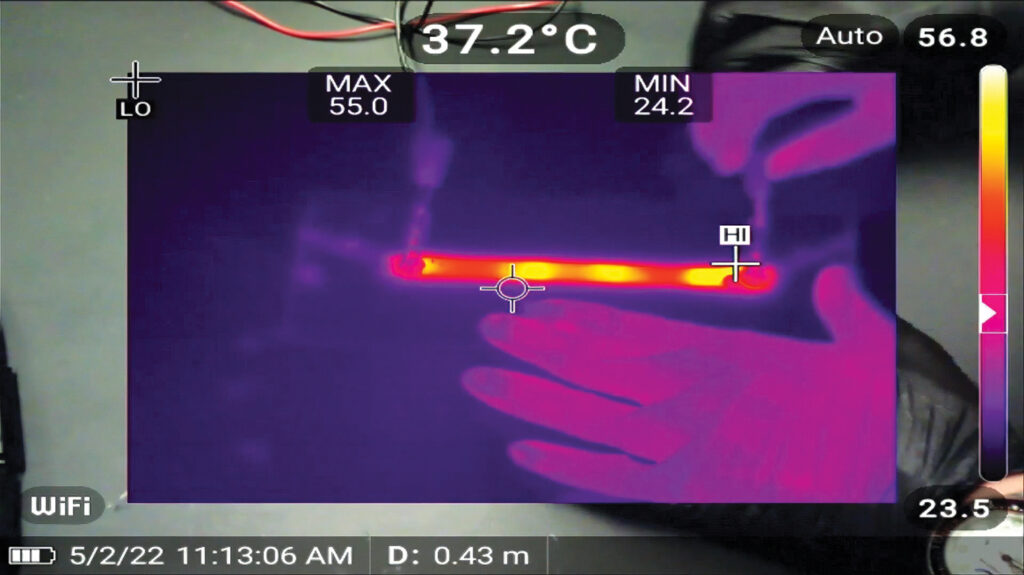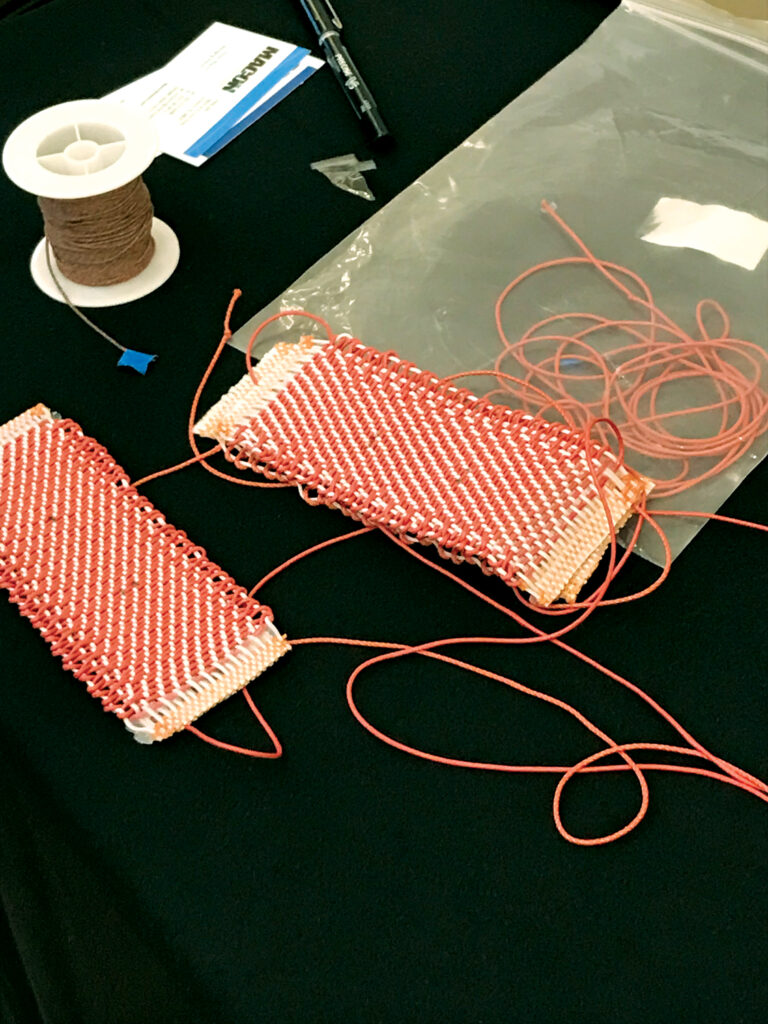
This year’s Smart Fabric Summit was again organized by the Advanced Textiles Association (ATA) and the Wilson College of Textiles, North Carolina State University (NC State) in Raleigh, N.C., and took place in April on the NC State campus. A full schedule of education, student project presentations and tours of the College of Textiles facilities were all part of this year’s event.
Next in medical textiles
A discussion of recent developments in medical textiles ranged from new device designs to the impact of intensive testing for personal protective equipment (PPE). Michelle Lishner, lead development engineer, Cortland Biomedical, offered updates on biomedical textile devices and their basic requirements. Textiles, generally, are well suited for medical devices, she said, “because
they are so customizable, can be fashioned at large scale, are lightweight, dependable and biocompatible.”
Lishner noted the direction likely for the future of medical textiles. “There is a desire to be thinner and smaller,” she said, “but they need to be stronger and more durable too.” The use of color in textile implants is a newer development. Color can help to indicate when or if there is some irregularity in the device’s placement inside the body.
R. Bryan Ormond, Ph.D., assistant professor in the Wilson College of Textiles, described the “mechanisms of protection for personal protective equipment” and how PPE is tested to determine efficacy. PPE must protect against agents that could be in a gas or vapor state, a liquid or an aerosol. The means of entry and how that endangers the body varies, so the means of protection for
each must be considered.
Testing is also varied—and complex—to address the type of agent, means of penetration and the PPE’s resistance to each. These could include bacterial and viral threats; liquids, such as blood or other body fluids; chemical dangers, including fuel, which responds quite differently from water; and particulates of all kinds in aerosol form.
One of the goals in developing new protective products is to reduce the huge quantity of waste generated every day from disposables by developing reusable products.
Liquid metal electronics
Braden Li, Ph.D., materials research engineer at the Air Force Life Cycle Management Center (LCMC) and the Air Force Research Laboratory (AFRL), explained a new technology being explored for textile-integrated liquid metal electronics that uses polymer architectures paired with printable liquid metal eutectic gallium-indium (EGaln) inks. This technology can create conformable and flexible functional textile electronics that could be used in heating, sensing and data routing.
There are multiple advantages in using this technology, according to Li, including that it’s highly stretchable and maintains durability for data transfer and power transfer. Textile-integrated liquid metal electronics can also be used in capacitive sensing devices, which has already been demonstrated in soft robotics developed in collaboration with GE. As EGaln is a nontoxic material, biocompatibility testing with the liquid metal in contact with skin showed no irritation caused by the device.
Additional textile-based wearables could be developed in sensing, haptics and virtual reality applications. Capacitive sensing has not been commercialized yet, but he says that it will be in the next couple of years.
Trade opportunities
Eric Sguazzin, international economist, U.S. Office of Textiles and Apparel (OTEXA), discussed Vice President Kamala Harris’ call to action in the Partnership for Central America. This is a public/private partnership targeting northern Central America and comes with a regional investment of $1.6 billion. The goal is to create more jobs in this region as well as to strengthen trade relationships.
Specifically, Sguazzin noted the importance of opening these foreign markets and combating unfair trade. The intention is to fully enforce U.S. trade laws, monitor compliance with agreements and use all available tools to hold other countries accountable.
Unique to this administration is its efforts to advance a worker-centered trade policy, which is consistent with a U.S. strategy to address migration’s root causes, beyond just economic drivers. The effort incorporates a focus on good governance and labor rights that are also essential in supporting the success of private-sector partners.
Sguazzin also pointed out the advantages to businesses in U.S. sourcing of their materials. These include lower energy and transportation costs, quicker turnaround time, and meeting the consumer preference for “made in USA” products.
OTEXA offers a Made in USA Sourcing & Products Directory (trade.gov/made-usa-directory) with more than 600 companies listed.

Advanced robotics manufacturing
Glen Saunders, senior research engineer, Manufacturing Innovation Center (MIC) at Rensselaer Polytechnic Institute, Troy, N.Y., described the work being done at MIC and a large network of institutes and collaborative industry partners that make up Manufacturing USA.
One of them, the Advanced Robotics for Manufacturing (ARM) Institute headquartered in Pittsburgh, Pa., supports innovations in manufacturing, with project management, funding mechanisms and the design of robotic systems for improved productivity and efficiencies in textile manufacturing.
These include using various types of robotics for sewing; doing the literal heavy lifting for large projects, such as tents; and providing assistance to human workers, as guided by the human operator. The company has also designed a robotic system for fusing fabric layers and a robotic assistant for composites layup.
Collaborative robots are designed specifically to work safely around human workers. “They’re slower,” Saunders says, “but they stop when approaching an obstacle and have other safety features.”
IP best practices
With new ideas and products comes the need to protect one’s intellectual property (IP). Dhruv Agarwal is vice president of sustainability, innovation and development with Kontoor Brands Inc., a company with major brands that include Wrangler® and Lee®. In a presentation titled “IP Best Practices When Going to Market,” he noted how ideas get to market, a process that includes identifying a need, problem or innovation driver; ideation; and collaboration.
His co-speaker, Cory Schug, a patent attorney with the Womble Bond Dickinson firm, elaborated on the role of collaboration. “If you don’t collaborate, it can be hard to move your idea forward. But with collaboration you need to be careful, so at least the intellectual property remains with you, so you own your idea.”
According to Schug, the key question is, “What do you need to do to make sure you don’t lose your rights to a patent? Essentially, you’ve got one year in the U.S. once your idea is made public. It’s even less outside of the U.S.”
Schug offered four main tips to avoid serious pitfalls.
1. Have a nondisclosure agreement (NDA) that will keep ideas confidential and avoid public disclosure. “It could be generic,” Schug said, “but who is bound by this NDA? With whom is it going to be shared? Is it mutual or is it unilateral?”
2. Have a consulting agreement, which assigns IP rights. “Make sure the proper people own it. That’s the biggest thing. It’s going to be a lot harder to get an agreement after you have a great product,” he added.
3. Conduct a freedom-to-operate patent search to be sure you own your intellectual property. “This is where you find out a lot of information you need to know about what you’re getting into—and to learn where there is room to put up your fence,” Schug said.
4. Analyze available and preferred forms of IP protection. This involves differentiating between a patent and a trade secret, where “there’s a fine line,” said Schug. Also, one should consider the usefulness of a trademark or copyright. “A contract can provide you significant protection but not everything,” he said. “But there is
a lot of protection that can be available that might be challenging to get in other ways.”
In the end, if you are concerned about finding the competition, “Be confident and move fast,” Agarwal suggested. Both presenters agreed that it’s smart to spend your money on innovation. “Don’t spend it all on patents,” Agarwal said. “You need to use your resources properly to get the product made and in the market.”
Janet Preus is senior editor of Textile Technology Source. She can be reached at janet.preus@textiles.org.
 TEXTILES.ORG
TEXTILES.ORG


